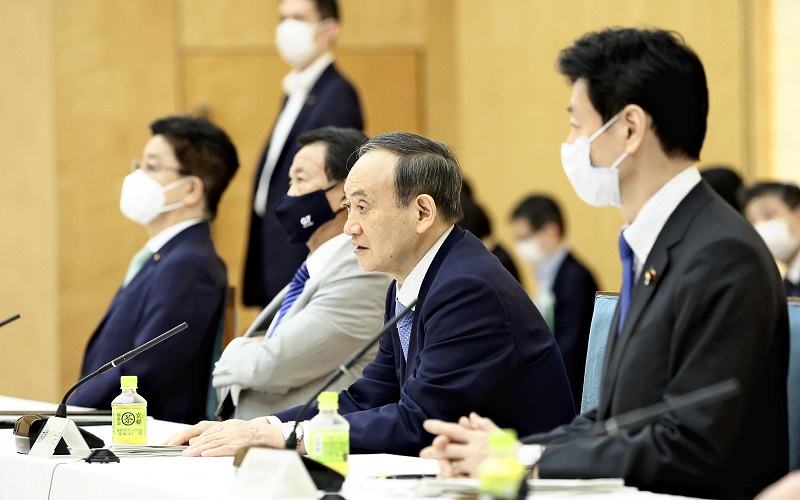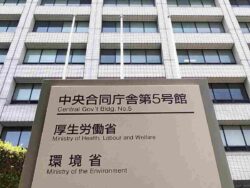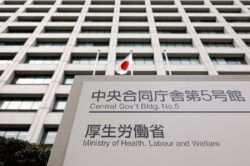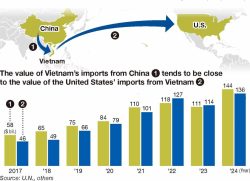
Prime Minister Yoshihide Suga, center, speaks at a meeting of the Council on Economic and Fiscal Policy held at the Prime Minister’s Office on June 9.
19:14 JST, June 13, 2021
The government will consider strengthening the power of various authorities, in a bid to help them respond better to the novel coronavirus pandemic, according to the draft of a basic plan for economic and fiscal management and reform.
The plan was presented Wednesday at a meeting of the Council on Economic and Fiscal Policy held at the Prime Minister’s Office. It also stipulated that renewable energy sources should be used as much as possible to usher in Japan’s transition to a decarbonized society.
According to the draft, authorities need greater powers to resolve issues such as the shortage of hospital beds for COVID-19 patients and securing enough medical personnel to treat them.
Prime Minister Yoshihide Suga, who chairs the council, said at the meeting that consideration would swiftly be given to establishing a legal framework for steps to secure sufficient numbers of hospital beds and medical personnel, and to quickly enable the practical use of medications and vaccines. The government will fine-tune the draft with the ruling parties and other entities, and aims to have the Cabinet approve it at a June 18 meeting.
As things stand now, the central and local governments may urge medical facilities to provide beds for patients and take other steps, but these requests have no legal basis. The government will consider setting up a system under which central and local authorities could instruct such facilities to cooperate in securing beds and medical staffers in an emergency such as the COVID-19 pandemic.
The pandemic has brought to light shortcomings in the ability of public health centers, which coordinate the admission of COVID-19 patients to hospitals for treatment, to function as control towers in such situations. The draft plan would strengthen the authority of the central and prefectural governments to coordinate the admission of patients to medical facilities depending on the severity of their illness, and clarify a division of roles in this process.
Fast-track approval for a vaccine currently takes about two to three months from the time a pharmaceutical company files an application. The draft plan says consideration will be given to speeding up this approval process.
The draft also urges increased digitization and greening the economy for future growth after the pandemic ends. The plan called for minimizing the financial burden shouldered by the public for electricity generated from renewable sources such as solar and wind power, and also boosting the adoption of such power sources as widely as possible. It also states that the nation’s nuclear power plants should be restarted, provided this can be done safely.
The draft plan emphasizes the digitization of public and private sector infrastructure systems will be completed in a burst within the next five years.
In response to supply chain backlogs arising due to U.S.-China tensions and the pandemic, the basic plan for the first time includes a security section in the economics field. Screening checks of people such as foreign students and researchers will be bolstered, and systems put in place to domestically produce and supply important technologies and commodities.
The ruling Liberal Democratic Party has proposed establishing a “children’s agency” to oversee policies that will support people raising children. With an eye to launching the agency, the draft plan says consideration will soon start on setting up an administrative organization.
Japan’s fiscal health has deteriorated rapidly as the government has churned out massive economic stimulus packages. The draft plan sticks to the government’s goal of running a primary balance surplus for central and local governments in fiscal 2025.
However, the plan calls for the pandemic’s impact on the economy to be carefully analyzed during the current fiscal year, while seeking a review of the target year for erasing the primary balance deficit. The target year could be pushed back, depending on the results of these checks.
"Society" POPULAR ARTICLE
-

Tokyo, Kanagawa Prefecture Warned of Record-Breaking Short-Duration Precipitation, Meguro Ward Logs 134 Millimeters for an Hour (Update 2)
-

Typhoon Peipah Forms Near Amami Oshima Island, Expected to Move toward East and Hit Shikoku, Kinki Regions
-

Multiple Bear Sightings in Western Tokyo Lead to Municipalities in Area Calling for People to Stay Vigilant
-

Statues of Naked Women Being Removed From Public Spaces; Meant As Symbols of Peace, Now Thought Inappropriate
-

United Airlines Boeing 737 Plane Makes Emergency Landing at Kansai Airport as Passengers Evacuate on Slides
JN ACCESS RANKING
-

Japan’s Seafood Exports Still Hurting in Wake of Fukushima Incident, but Hopes Rising for Chinese Market
-

Japan’s Core Inflation Slows in July, Stays above BOJ Target
-

Japan in Prime Spot for Total Lunar Eclipse Early Monday Morning, 1st Visible from Country in Almost 3 Years
-

Japan, India Aim for More Than 500,000 People-to People Exchanges over Next 5 Years
-

S. Korea’s Lee Eager to Enhance Ties with Japan More





















